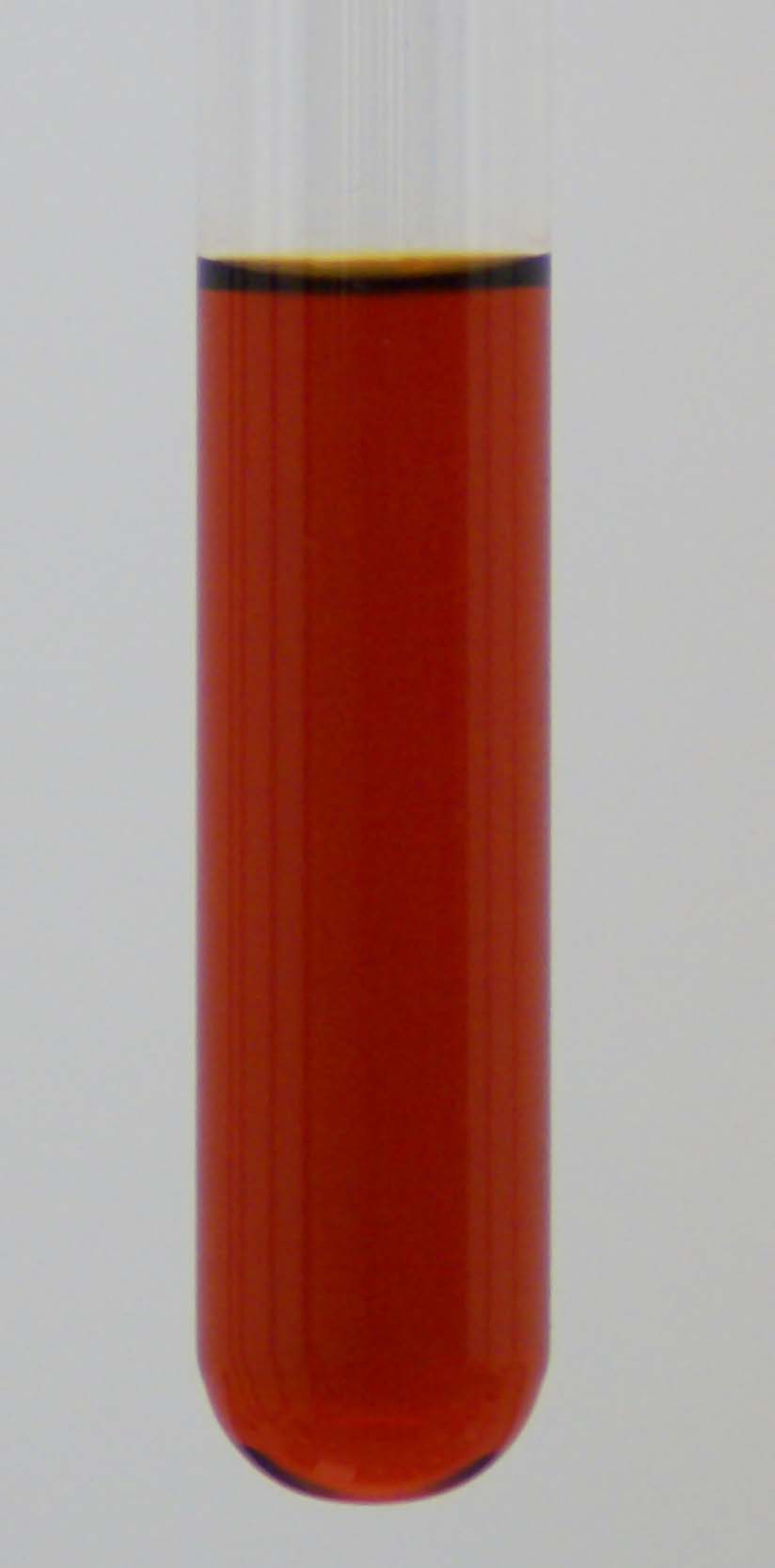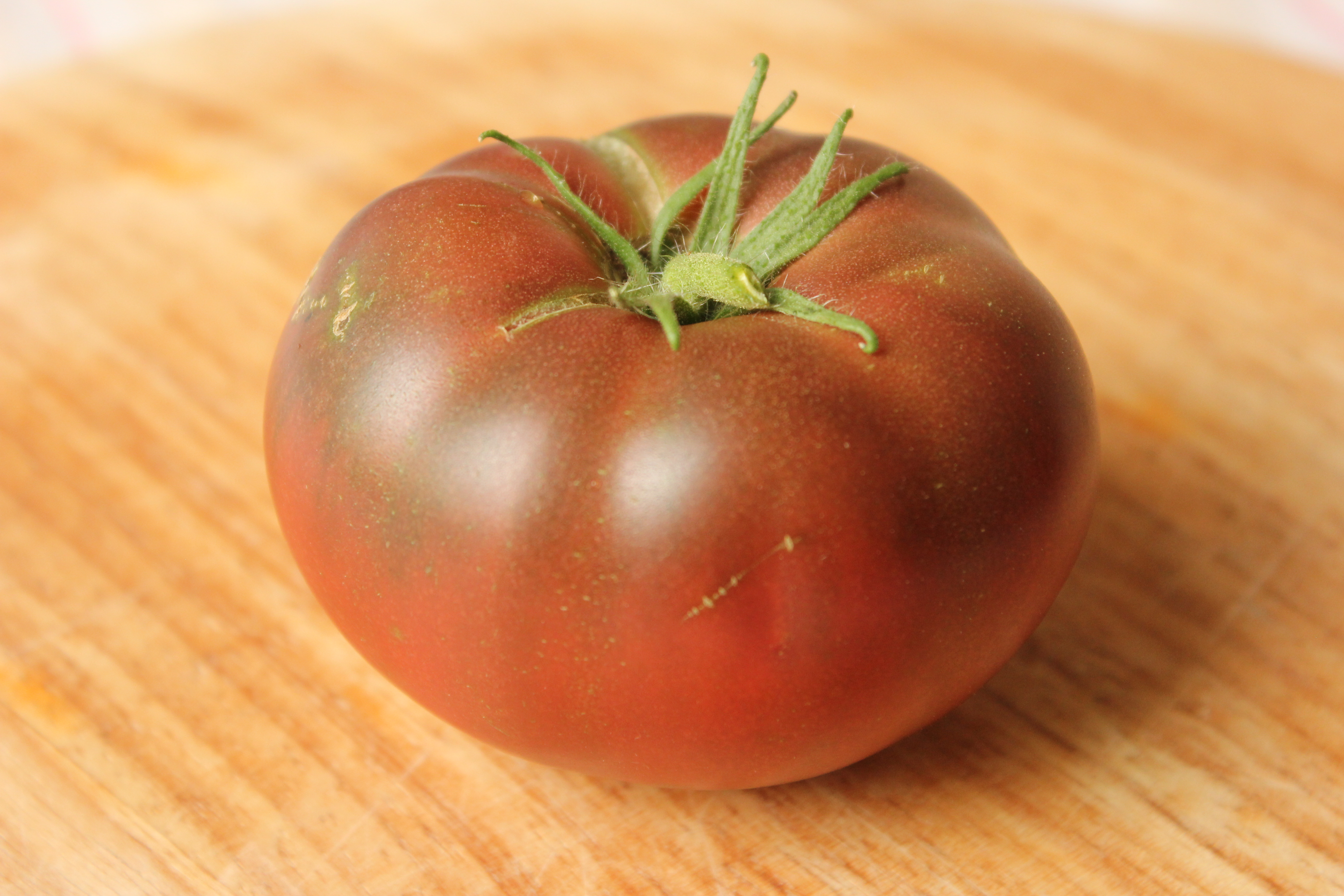|
Blue Tomato
Blue tomatoes, sometimes referred to as purple tomato, are tomatoes that have been bred to produce high levels of anthocyanins, a class of pigments responsible for the blue and purple colours of many fruits, including blueberries, blackberries and chokeberries. Anthocyanins may provide protection for the plant against insects, diseases, and ultraviolet radiation. Some of these tomatoes have been commercialized under the names "Indigo Rose" and "SunBlack". Conventional breeding While tomatoes have the genes for producing anthocyanins, these genes are typically not expressed in the fruit in most commercial varieties. The result is that the pigments are limited to leaves and stems, where they are not eaten. As of the 2012 growing season, Oregon State University developed blue tomato seeds became commercially available under the cultivar name "Indigo Rose". The blue color is produced mostly by the anthocyanin petunidin on the outside of the tomato where the fruit is exposed to ... [...More Info...] [...Related Items...] OR: [Wikipedia] [Google] [Baidu] |
Transcription Factor
In molecular biology, a transcription factor (TF) (or sequence-specific DNA-binding factor) is a protein that controls the rate of transcription of genetic information from DNA to messenger RNA, by binding to a specific DNA sequence. The function of TFs is to regulate—turn on and off—genes in order to make sure that they are expressed in the desired cells at the right time and in the right amount throughout the life of the cell and the organism. Groups of TFs function in a coordinated fashion to direct cell division, cell growth, and cell death throughout life; cell migration and organization (body plan) during embryonic development; and intermittently in response to signals from outside the cell, such as a hormone. There are up to 1600 TFs in the human genome. Transcription factors are members of the proteome as well as regulome. TFs work alone or with other proteins in a complex, by promoting (as an activator), or blocking (as a repressor) the recruitment of RNA ... [...More Info...] [...Related Items...] OR: [Wikipedia] [Google] [Baidu] |
Lycopene
Lycopene is an organic compound classified as a tetraterpene and a carotene. Lycopene (from the neo-Latin ''Lycopersicum'', the tomato species) is a bright red carotenoid hydrocarbon found in tomatoes and other red fruits and vegetables. Occurrence Aside from tomatoes, it is found in red carrots, watermelons, grapefruits, and papayas. It is not present in strawberries or cherries. It has no vitamin A activity. In plants, algae, and other photosynthetic organisms, lycopene is an intermediate in the biosynthesis of many carotenoids, including beta-carotene, which is responsible for yellow, orange, or red pigmentation, photosynthesis, and photoprotection. Like all carotenoids, lycopene is a tetraterpene. It is insoluble in water. Eleven conjugated double bonds give lycopene its deep red color. Owing to the strong color, lycopene is useful as a food coloring (registered as E160d) and is approved for use in the US, Australia and New Zealand (registered as 160d) and the European ... [...More Info...] [...Related Items...] OR: [Wikipedia] [Google] [Baidu] |
Carotenoids
Carotenoids (), also called tetraterpenoids, are yellow, orange, and red organic pigments that are produced by plants and algae, as well as several bacteria, and fungi. Carotenoids give the characteristic color to pumpkins, carrots, parsnips, corn, tomatoes, canaries, flamingos, salmon, lobster, shrimp, and daffodils. Carotenoids can be produced from fats and other basic organic metabolic building blocks by all these organisms. It is also produced by endosymbiotic bacteria in whiteflies. Carotenoids from the diet are stored in the fatty tissues of animals, and exclusively carnivorous animals obtain the compounds from animal fat. In the human diet, absorption of carotenoids is improved when consumed with fat in a meal. Cooking carotenoid-containing vegetables in oil and shredding the vegetable both increase carotenoid bioavailability. There are over 1,100 known carotenoids which can be further categorized into two classes, xanthophylls (which contain oxygen) and carote ... [...More Info...] [...Related Items...] OR: [Wikipedia] [Google] [Baidu] |
Pheophytin
Pheophytin or phaeophytin is a chemical compound that serves as the first electron carrier intermediate in the electron transfer pathway of Photosystem II (PS II) in plants, and the type II photosynthetic reaction center (RC P870) found in purple bacteria. In both PS II and RC P870, light drives electrons from the reaction center through pheophytin, which then passes the electrons to a quinone (QA) in RC P870 and RC P680. The overall mechanisms, roles, and purposes of the pheophytin molecules in the two transport chains are analogous to each other. Structure In biochemical terms, pheophytin is a chlorophyll molecule lacking a central Mg2+ ion. It can be produced from chlorophyll by treatment with a weak acid, producing a dark bluish waxy pigment. The probable etymology comes from this description, with ''pheo'' meaning ''dusky'' and ''phyt'' meaning ''vegetation''. [...More Info...] [...Related Items...] OR: [Wikipedia] [Google] [Baidu] |
Chlorophyll
Chlorophyll (also chlorophyl) is any of several related green pigments found in cyanobacteria and in the chloroplasts of algae and plants. Its name is derived from the Greek words , ("pale green") and , ("leaf"). Chlorophyll allow plants to absorb energy from light. Chlorophylls absorb light most strongly in the blue portion of the electromagnetic spectrum as well as the red portion. Conversely, it is a poor absorber of green and near-green portions of the spectrum. Hence chlorophyll-containing tissues appear green because green light, diffusively reflected by structures like cell walls, is less absorbed. Two types of chlorophyll exist in the photosystems of green plants: chlorophyll ''a'' and ''b''. History Chlorophyll was first isolated and named by Joseph Bienaimé Caventou and Pierre Joseph Pelletier in 1817. The presence of magnesium in chlorophyll was discovered in 1906, and was that element's first detection in living tissue. After initial work done by German chemi ... [...More Info...] [...Related Items...] OR: [Wikipedia] [Google] [Baidu] |
Cherokee Purple
Cherokee Purple is the name of an old variety of tomato that develops a fruit with a deep, dusky-rose color while maintaining a somewhat greenish hue near the stem when mature for eating. The deep crimson interior and clear skin combination give it its distinctive color. It was one of the first of the darker color group of tomatoes sometimes described as "blacks." Southern Exposure Seed Exchange was the first seed company to offer Cherokee Purple, released in limited quantity in 1993. The Cherokee Purple has become a popular heirloom variety. History In 1990 John Green of Sevierville, Tennessee mailed heirloom tomato expert Craig LeHoullier seeds of an unnamed purple tomato. Green said that the tomato had originated with the Cherokees more than 100 years previously. LeHoullier named the tomato "Cherokee Purple" and sent seeds to the Southern Exposure Seed Exchange (SESE). Jeff McCormack, the owner of SESE, said that the tomato "tasted fine, but was kind of ugly -- people may ... [...More Info...] [...Related Items...] OR: [Wikipedia] [Google] [Baidu] |
Black Krim (tomato)
The Black Krim (also known as Black Crimea and Noire de Crimée) is an heirloom tomato originating from Crimea. The plant is open-pollinated, indeterminate, bearing 8 ounce flattened globe fruits that are dark reddish-purple to black with green/brown shoulders. In 1990 it became the first "black" tomato to be commercially available in the United States. References See also * List of tomato cultivars * Heirloom tomato An heirloom tomato (also called heritage tomato in the United Kingdom, UK) is an Open pollination, open-pollinated, non-hybrid heirloom plant, heirloom cultivar of tomato. They are classified as family heirlooms, commercial heirlooms, mystery heir ... Tomato cultivars {{vegetable-stub ... [...More Info...] [...Related Items...] OR: [Wikipedia] [Google] [Baidu] |
Greenhouse
A greenhouse (also called a glasshouse, or, if with sufficient heating, a hothouse) is a structure with walls and roof made chiefly of Transparent ceramics, transparent material, such as glass, in which plants requiring regulated climatic conditions are grown.These structures range in size from small sheds to industrial-sized buildings. A miniature greenhouse is known as a cold frame. The interior of a greenhouse exposed to sunlight becomes significantly warmer than the external temperature, protecting its contents in cold weather. Many commercial glass greenhouses or hothouses are high tech production facilities for vegetables, flowers or fruits. The glass greenhouses are filled with equipment including screening installations, heating, cooling, and lighting, and may be controlled by a computer to optimize conditions for plant growth. Different techniques are then used to manage growing conditions, including air temperature, relative humidity and vapour-pressure deficit, in ord ... [...More Info...] [...Related Items...] OR: [Wikipedia] [Google] [Baidu] |
Cathie Martin
Catherine Rosemary Martin (born April 1955) is a Professor of Plant Sciences at the University of East Anglia and project leader at the John Innes Centre, Norwich, co-ordinating research into the relationship between diet and health and how crops can be fortified to improve diets and address escalating chronic disease globally. Education Martin received a First Class Honours degree in Natural Sciences from the University of Cambridge. She then went on to obtain her PhD in Biochemistry in 1981, also from Cambridge. Research and career Her research has included work on blood oranges, and purple, high anthocyanin tomatoes. After a period as a postdoctoral research fellow at the University of Cambridge she moved to the John Innes Centre's Department of Genetics in 1983. She was the first to identify genes which regulated cell shape in plants. Since 2000, Cathie's research has focused on diet and health, researching how crops can be fortified to combat chronic disease across t ... [...More Info...] [...Related Items...] OR: [Wikipedia] [Google] [Baidu] |
Jonathan D
Jonathan may refer to: *Jonathan (name), a masculine given name Media * ''Jonathan'' (1970 film), a German film directed by Hans W. Geißendörfer * ''Jonathan'' (2016 film), a German film directed by Piotr J. Lewandowski * ''Jonathan'' (2018 film), an American film directed by Bill Oliver * ''Jonathan'' (Buffy comic), a 2001 comic book based on the ''Buffy the Vampire Slayer'' television series * ''Jonathan'' (TV show), a Welsh-language television show hosted by ex-rugby player Jonathan Davies People and biblical figures Bible * Jonathan (1 Samuel), son of King Saul of Israel and friend of David, in the Books of Samuel *Jonathan (Judges), in the Book of Judges Judaism *Jonathan Apphus, fifth son of Mattathias and leader of the Hasmonean dynasty of Judea from 161 to 143 BCE *Rabbi Jonathan, 2nd century *Jonathan (High Priest), a High Priest of Israel in the 1st century Other *Jonathan (apple), a variety of apple * "Jonathan" (song), a 2015 song by French singer and songwrit ... [...More Info...] [...Related Items...] OR: [Wikipedia] [Google] [Baidu] |

.jpg)

